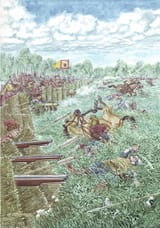Search Results
7/26/2025, 8:46:24 AM
>>511393208
Why are you so mad?
Why are you so mad?
7/20/2025, 2:24:03 AM
>>17851376
>rifling
Even without rifling they are reasonably accurate, before the battlefield is filled with smoke they can hit a target at 50 meters and have a decent chance of a hit at 100 meters.
https://www.youtube.com/watch?v=trgZmM9fNS0
>extremely difficult to hit a horseman in motion
It is a numbers game.
If the horse archers attack in a dense formation, the musketeer just needs to aim slightly above the horizon and they will hit something. If they are dispersed, then there will be maybe 1 or 2 horse archers within range of 10 musketeers. Our Cossack musketeers would be in their wagon circle with boxes of powder and shot firing all day, densely packed, taking turns to fire through the slots before reloading, they can do this all day, their arms aching but nothing compared to the aches of their opponents, whose horses will suffer from heat exhaustion (which is why Mongols warrior had 3 horses each).
>The Cossacks had mixed success
The 16th century saw a sudden rapid expansion east,
>the average weapon used by a Russian soldier was the compound bow
Bows continued to be used until the flintlock and the Russians employed steppe peoples with their horse archers as allies, but they were not the "average" weapon by the end of the 16th century, neither did they confer much advantage against the similarly armed steppe peoples.
>it worked surprisingly well into the early 20th century
Whatever battle you are referring to did not represent warfare in the early 20th century, this is quite a wild claim.
>Napoleonic cavalry tactics sucked. There's a reason why no one outside of Europe adopted it.
18th century and Napoleonic era cavalry were light cavalry, little different from light cavalry anywhere else in the world. If it "sucked", well, then so did everyone else's. In battles between the British and India, often half the army were light cavalry and functioned much the same way as light cavalry in Europe.
>rifling
Even without rifling they are reasonably accurate, before the battlefield is filled with smoke they can hit a target at 50 meters and have a decent chance of a hit at 100 meters.
https://www.youtube.com/watch?v=trgZmM9fNS0
>extremely difficult to hit a horseman in motion
It is a numbers game.
If the horse archers attack in a dense formation, the musketeer just needs to aim slightly above the horizon and they will hit something. If they are dispersed, then there will be maybe 1 or 2 horse archers within range of 10 musketeers. Our Cossack musketeers would be in their wagon circle with boxes of powder and shot firing all day, densely packed, taking turns to fire through the slots before reloading, they can do this all day, their arms aching but nothing compared to the aches of their opponents, whose horses will suffer from heat exhaustion (which is why Mongols warrior had 3 horses each).
>The Cossacks had mixed success
The 16th century saw a sudden rapid expansion east,
>the average weapon used by a Russian soldier was the compound bow
Bows continued to be used until the flintlock and the Russians employed steppe peoples with their horse archers as allies, but they were not the "average" weapon by the end of the 16th century, neither did they confer much advantage against the similarly armed steppe peoples.
>it worked surprisingly well into the early 20th century
Whatever battle you are referring to did not represent warfare in the early 20th century, this is quite a wild claim.
>Napoleonic cavalry tactics sucked. There's a reason why no one outside of Europe adopted it.
18th century and Napoleonic era cavalry were light cavalry, little different from light cavalry anywhere else in the world. If it "sucked", well, then so did everyone else's. In battles between the British and India, often half the army were light cavalry and functioned much the same way as light cavalry in Europe.
Page 1

